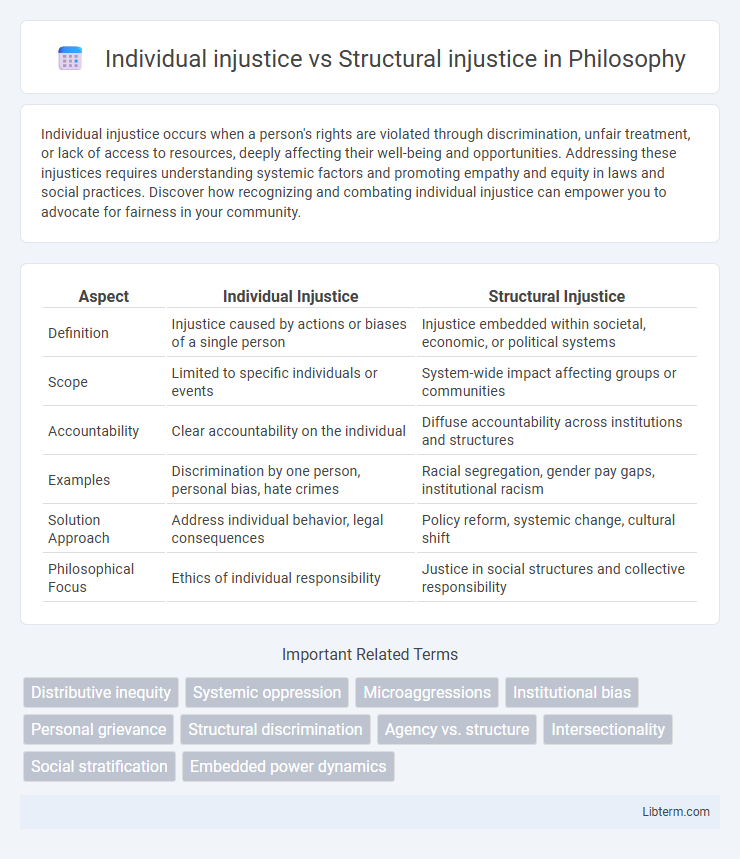Individual injustice occurs when a person's rights are violated through discrimination, unfair treatment, or lack of access to resources, deeply affecting their well-being and opportunities. Addressing these injustices requires understanding systemic factors and promoting empathy and equity in laws and social practices. Discover how recognizing and combating individual injustice can empower you to advocate for fairness in your community.
Table of Comparison
| Aspect | Individual Injustice | Structural Injustice |
|---|---|---|
| Definition | Injustice caused by actions or biases of a single person | Injustice embedded within societal, economic, or political systems |
| Scope | Limited to specific individuals or events | System-wide impact affecting groups or communities |
| Accountability | Clear accountability on the individual | Diffuse accountability across institutions and structures |
| Examples | Discrimination by one person, personal bias, hate crimes | Racial segregation, gender pay gaps, institutional racism |
| Solution Approach | Address individual behavior, legal consequences | Policy reform, systemic change, cultural shift |
| Philosophical Focus | Ethics of individual responsibility | Justice in social structures and collective responsibility |
Understanding Individual Injustice: Key Concepts
Individual injustice refers to wrongful acts committed by a person that violate another's rights, involving personal accountability and specific incidents, such as discrimination or assault. Key concepts include intent, harm, and moral responsibility, emphasizing the individual's role in perpetuating injustice. This contrasts with structural injustice, which arises from systemic inequalities embedded in social, economic, or political institutions.
Defining Structural Injustice: A Broader Perspective
Structural injustice refers to systemic patterns and institutional practices that create and perpetuate inequality and discrimination across society, often embedded in laws, policies, and social norms. Unlike individual injustice, which involves personal acts of unfairness or harm, structural injustice operates on a macro level, influencing economic, political, and cultural frameworks that affect groups disproportionately. Recognizing structural injustice requires analyzing historical and societal contexts that shape unequal power dynamics, ensuring interventions target root causes rather than isolated incidents.
Historical Roots of Individual and Structural Injustice
Individual injustice stems from personal biases and actions rooted in historical prejudices reinforced by cultural norms and discriminatory practices. Structural injustice originates from institutional systems established over time, such as legal frameworks and economic policies that historically marginalized specific groups, perpetuating inequality. Understanding the historical roots reveals how centuries of slavery, colonization, and segregation shaped both personal attitudes and systemic barriers.
How Individual Actions Perpetuate Injustice
Individual actions perpetuate injustice by reinforcing systemic inequalities through everyday behaviors, choices, and biases that maintain discriminatory practices. Implicit biases and prejudiced decisions by individuals contribute to disparities in areas such as education, employment, and law enforcement, embedding structural barriers within societal institutions. These micro-level injustices accumulate, sustaining and legitimizing broader structural injustices over time.
The Role of Institutions in Structural Injustice
Institutions play a critical role in perpetuating structural injustice by embedding discriminatory policies, unequal resource distribution, and biased power dynamics into legal, economic, and social systems. These systemic mechanisms sustain disparities across race, gender, and class, often remaining invisible through normalized practices and institutional inertia. Addressing structural injustice requires transforming institutional frameworks to promote equity, accountability, and inclusive decision-making processes.
Case Studies: Comparing Individual vs. Structural Injustice
Case studies comparing individual injustice and structural injustice reveal that individual injustice often involves personal acts of discrimination or bias, such as racially motivated police brutality in the George Floyd case, whereas structural injustice encompasses systemic inequities embedded in institutions, like redlining policies that perpetuate racial housing segregation. Research on the Flint water crisis exemplifies structural injustice by demonstrating how government negligence disproportionately affected minority communities, highlighting the role of institutional policies rather than isolated actions. These comparisons emphasize that addressing injustice requires both accountability for individual perpetrators and comprehensive reforms targeting systemic disparities in social, economic, and political frameworks.
Consequences of Ignoring Structural Injustice
Ignoring structural injustice perpetuates systemic inequality by allowing embedded discriminatory practices to persist unchallenged, resulting in widespread social and economic disparities. Individual efforts to address injustice fall short when broader institutional policies and cultural norms remain unaltered, leading to recurring cycles of marginalization. The failure to confront structural injustice undermines social cohesion and inhibits sustainable progress toward equity.
Addressing Individual Injustice: Legal and Social Approaches
Addressing individual injustice involves applying legal frameworks such as criminal justice, civil rights laws, and anti-discrimination policies to hold specific actors accountable and provide remedies to victims. Social approaches emphasize restorative justice, community mediation, and advocacy to empower affected individuals and promote healing. Effective intervention requires combining judicial enforcement with social support systems to combat immediate harm and facilitate long-term equity.
Strategies for Combating Structural Injustice
Strategies for combating structural injustice include implementing comprehensive policy reforms aimed at dismantling systemic inequalities embedded in institutions such as education, criminal justice, and housing. Community empowerment initiatives, like grassroots organizing and participatory decision-making, foster collective action to challenge entrenched power dynamics. Data-driven accountability measures ensure transparency and guide equitable resource distribution to marginalized groups most affected by structural discrimination.
Building Equitable Societies: Integrating Both Perspectives
Building equitable societies requires addressing both individual injustice, rooted in personal prejudices and discriminatory actions, and structural injustice, embedded in systemic inequalities across institutions and policies. Solutions must integrate reforms targeting biased law enforcement and education systems with community-driven initiatives that promote inclusivity and equal access to resources. Recognizing the interplay between individual behaviors and institutional frameworks enables a comprehensive approach to justice that transforms societal norms and eradicates deep-rooted disparities.
Individual injustice Infographic

 libterm.com
libterm.com